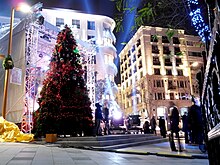New Year's tree
[2] New Year's trees are common in various cultures and nations, chiefly the former Soviet Union, former Yugoslavia, Albania, Turkey, China and Vietnam.
: Ёлка) for Christmas dates back to the 17th century when Peter the Great imported the practice as a result of his travels in Europe.
After the revolution of 1917, Christmas celebrations—along with other religious holidays—were discouraged and de facto prohibited as a result of the Soviet antireligious campaign.
[9] In his letter, Postyshev wrote: In the pre-revolutionary era the bourgeoisie and the capitalist officials always put up a tree for their children on New Year.
The Young Pioneer scout leaders are called upon to organize holiday celebrations for the children that feature New Year's trees.
There should not be a single village or community farm where the local board, along with members of the Young Communist League, does not provide a New Year's tree for their kids.
I'm sure the Young Communists will take a very active part in this enterprise and do away with the silly misconception that the New Year's tree is a bourgeois excess.
[citation needed] After the dissolution of the USSR, stigma against religion subsided amidst renewed public interest.
In 2024, when students of the Yıldız Technical University in Istanbul tried to decorate a tree, islamically motivated protesters tried to prevent it, saying that it had no place in Turkey.




